TORONTO (June 12) — It remains one of hockey’s abiding mysteries: How is it that Paul Henderson, who scored arguably the most–influential and illustrious goal in the game’s history, cannot qualify as a member of the Hockey Hall of Fame? It seems the more–often this inequity is raised, the harder the Hall digs in its heels. The perception of obstinacy and reluctance exudes, fairly or not, from those entrusted with the selection process. No matter how frequent the argument is made that the historic building in downtown Toronto is not the Hockey Hall of Statistics or the Hockey Hall of Lifetime Achievement, Paul Henderson remains on the outside. No player — not Bobby Orr, Wayne Gretzky or Gordie Howe — has achieved such an enduring level of “fame” for a single moment as did Henderson upon scoring the decisive goal for Canada in the 1972 Summit Series with the Russians. The goalie Henderson beat on Sep. 28th of that year, Vladislav Tretiak, was honored with induction in 1989. But, somehow, there’s still no place for the scorer.
Yet another opportunity will arise this month when the Selection Committee announces its inductees for the Class of 2020. To the exclusion of virtually all other consideration, the 18–member Committee will again focus on statistical achievement in the National Hockey League. It’s right there on the Hall’s website. Above a list of eligible candidates, it reads: “The forwards and defensemen listed (in first–year eligibility) played a minimum of 1,000 NHL regular season games or recorded a minimum of 300 goals, 400 assists or 700 points.” About goalie contenders, it reads: “The below list includes only first–year eligible goaltenders that played a minimum of 400 NHL regular season games, won over 200 NHL games, or recorded 25 or more NHL shutouts.” Given that only NHL numbers are of import, the 2020 favorites include Jarome Iginla (625 goals / 1,300 points) and Marian Hossa (525 goals / 1,134 points). An article written by Dan Rosen for the NHL.com website last Nov. 19 also includes, as possibilities, Alex Mogilny, Sergei Gonchar, Daniel Alfredsson, Patrick Elias, Rod Brind’Amour, Jeremy Roenick, Curtis Joseph, Pierre Turgeon, Theo Fleury, Kevin Lowe, Doug Wilson and Boris Mikhailov — the latter in his 37th year of eligibility. Nowhere is the name Paul Henderson.

AMONG THE MOST–ICONIC IMAGES IN CANADIAN SPORTS HISTORY WAS CAPTURED BY TORONTO STAR PHOTOGRAPHER FRANK LENNON, SECONDS AFTER PAUL HENDERSON’S SERIES–WINNING GOAL AGAINST THE RUSSIANS — IN MOSCOW — ON SEP. 28, 1972. IT SHOWS HENDERSON LEAPING INTO THE ARMS OF CANADIAN TEAMMATE YVAN COURNOYER, WITH SOVIET NETMINDER VLADISLAV TRETIAK PRONE IN THE CREASE. FOR THIS MOMENT, ALONE, HENDERSON DESERVES INDUCTION INTO THE HOCKEY HALL OF FAME. YET, THE SELECTION COMMITTEE, UNJUSTIFIABLY, REMAINS OBSTINATE.
Beyond NHL statistics, neither can anyone provide an adequate explanation. Though Henderson does not qualify amid the HHOF numeric guidelines (300 goals, 400 assists or 700 points), he was hardly a bum. In 707 NHL games with Detroit, Toronto and Atlanta from 1963–74; then in 1979–80, he scored 236 goals and accrued 477 points. He struck for at least 20 goals in seven NHL seasons, including a career–best 38 with the Toronto Maple Leafs in 1971–72. He belongs in the Hall of Fame solely for his exploits in the 1972 Summit Series (the winning goal for Canada in the last three games). If you throw in his more–than–decent NHL numbers, it really is a no–brainer. Tretiak is an honored member having never played a game in the NHL. He secured induction by virtue of his preeminence on the International stage. So, we ask again: Why can’t Paul Henderson be similarly recognized? We’re closing in on 50 years since the illustrious goal Henderson scored on Tretiak. Nothing about his exclusion is logical or pragmatic. If anything, it seems conspiratorial.
Interestingly enough, and though it shouldn’t matter, Hall of Fame chairman Lanny McDonald — as a rookie with the Maple Leafs in 1973–74 — was a teammate of Henderson’s. The veteran left–winger had 24 goals and 55 points in 69 games before incurring a contract stalemate with owner Harold Ballard. As such, he defected to the Toronto Toros of the rival World Hockey Association. Neither should that transgression be held against Henderson by the Hall. Such others as Bobby Hull, Gerry Cheevers, Frank Mahovlich, Dave Keon and Bernie Parent did the same and are honored members. As mentioned, no compelling, rational argument (beyond NHL statistics) has ever been made for keeping Henderson, now 77 and having battled cancer for 11 years, out of the Hall. His “fame” far outreaches many of those that are long–time inductees.
BASEBALL TREASURES — Part 3
The First World Series
More from my collection of Toronto Blue Jays memorabilia — this from 1992, when the Jays finally stopped teasing their fans and became the first team from outside the United States to win the World Series:
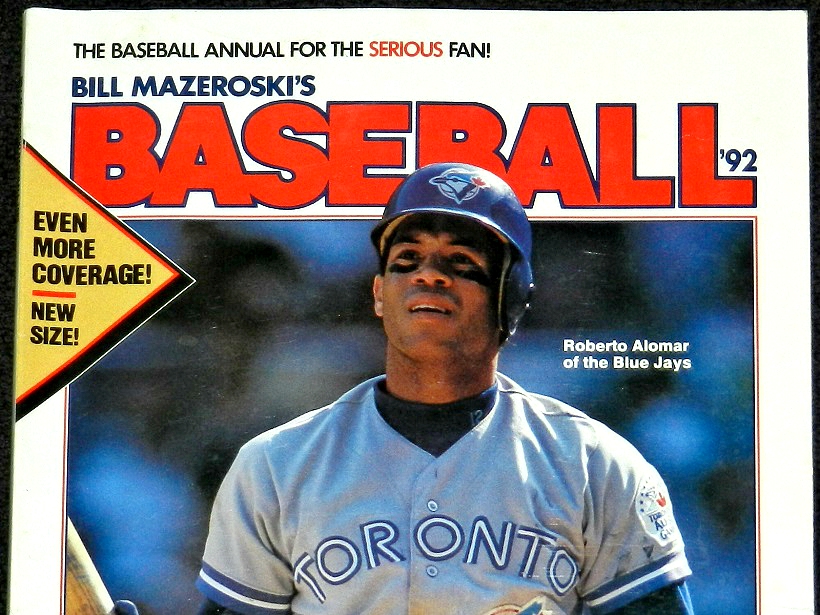
This preview magazine came close to its prediction of Toronto and Pittsburgh meeting in the 1992 World Series. The Blue Jays defeated Oakland in the American League Championship Series and the Pirates had a 2–1 lead over Atlanta heading to the bottom of the ninth in Game 7 of the National League Championship Series. But, a two–run single by Francisco Cabrera (b. Oct. 10, 1966) dramatically won the NLCS for the Braves at Atlanta Fulton–County Stadium. The magazine chose the Pirates to beat the Blue Jays in ’92.

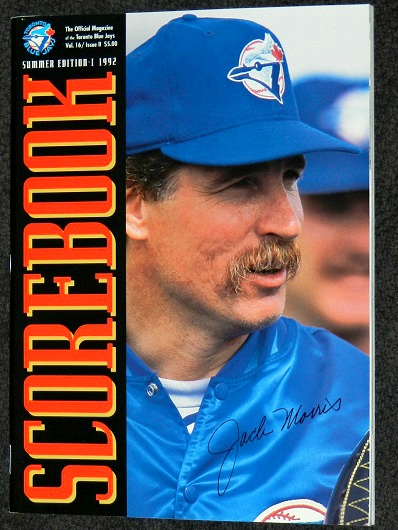
Two editions of the Blue Jays Scorebook Magazine from SkyDome in 1992. Top–left: Barry Bonds (b. July 24, 1964) was still playing for Pittsburgh, prior to his big (and tainted) home run seasons with San Francisco. Top–right: Hall–of–Fame pitcher Jack Morris (b. May 16, 1955) signed with the Blue Jays as an unrestricted free agent after a memorable performance for Minnesota in Game 7 of the 1991 World Series — not allowing a run over 10 innings as the Twins edged Atlanta for the championship. In 34 starts, Morris went 21–6 for the 1992 Blue Jays, becoming the first 20–game winner in franchise history.
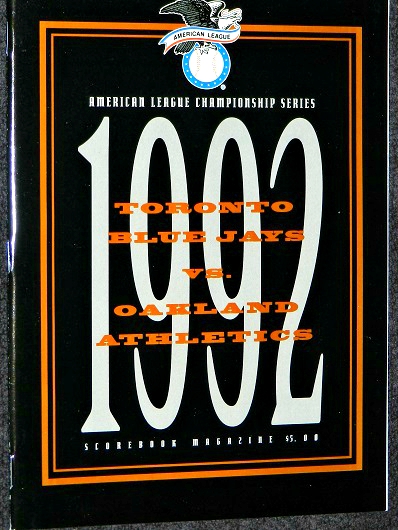
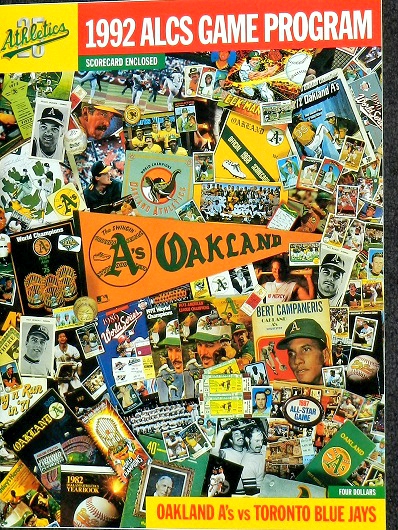
Programs from Toronto (top–left) and Oakland in the 1992 American League Championship Series — best–remembered, in these parts, for the game–tying home run by Roberto Alomar (b. Feb. 5, 1968) off Dennis Eckersley (b. Oct. 3, 1954) in the top of the ninth inning of Game 4. Alomar took Eckersley over the right–field wall at the Oakland Coliseum and the Blue Jays won the match in extra innings to grab a 3–1 lead in the series. I’ll always remember watching the home run from field–level at the Coliseum with Blue Jays broadcaster Jerry Howarth (b. Mar. 12, 1946). We stood next to the visitors’ dug–out and were 30 feet to the right of home plate for that remarkable moment. Toronto won the ALCS at the SkyDome in Game 6.
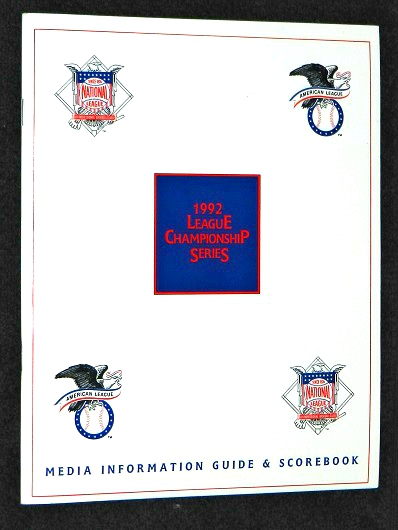
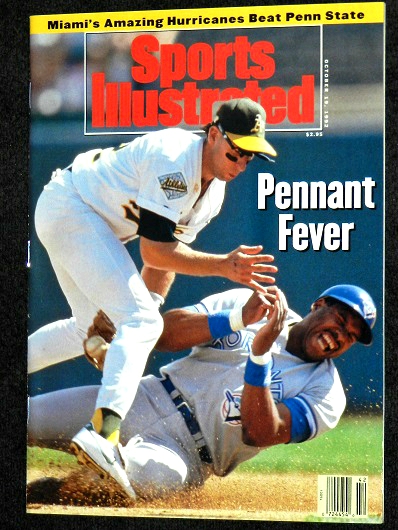
During the ’92 ALCS, Sports Illustrated (top–right) showed Dave Winfield (b. Oct. 3, 1951) of the Blue Jays sliding into second base at the Coliseum and colliding with A’s shortstop Walt Weiss (b. Nov. 28, 1963).
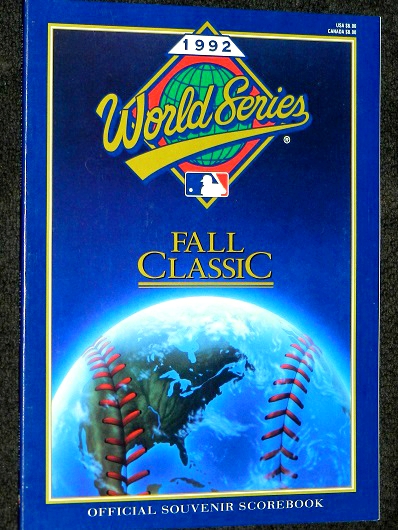
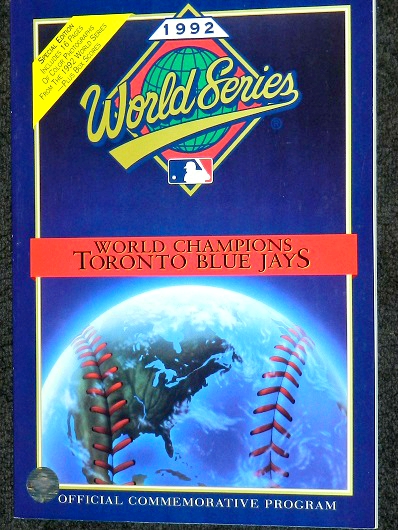
Toronto–Atlanta World Series program (top–left) and a post–series commemorative edition.
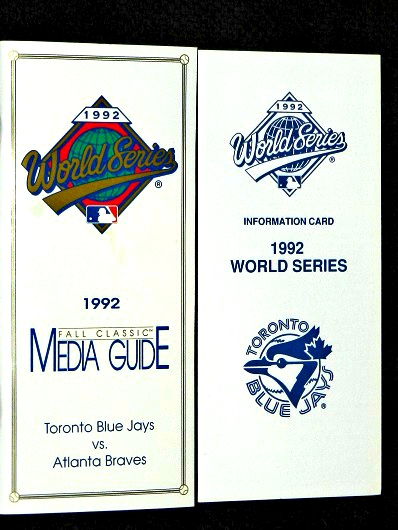
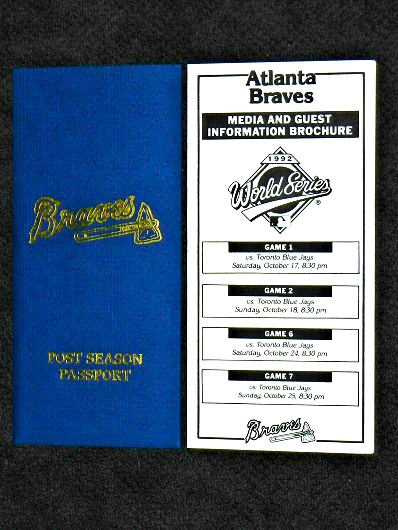
Media stuff from the 1992 World Series — in Toronto (left) and Atlanta.
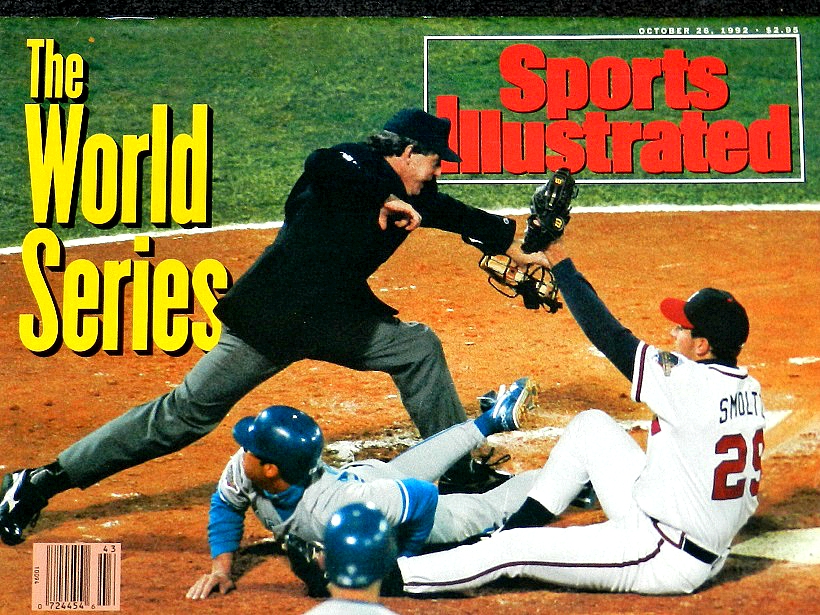
Sports Illustrated (Oct. 26, 1992 edition), published during the 1992 World Series. Cover photo (top) shows umpire Mike Reilly (b. July 2, 1949) calling Robbie Alomar out at the plate in the top of the fourth inning of Game 1 at Fulton–County Stadium; replays indicated Alomar was safe after bolting home from third on a wild pitch by Atlanta starter John Smoltz (b. May 15, 1967). Catcher Damon Berryhill (b. Dec. 3, 1963) retrieved the ball and tossed to Smoltz, who tagged Alomar. Berryhill (bottom–left) hit a three–run homer off Jays starter Jack Morris in the bottom of the sixth. The U.S. Marine Color Guard caused an international incident by mistakenly flying the Canadian flag upside down (bottom–right) prior to the national anthems.
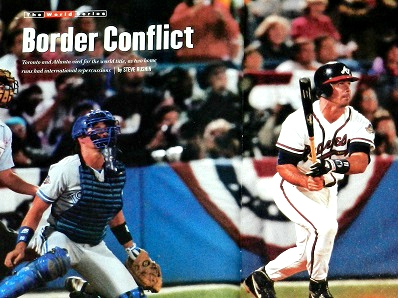
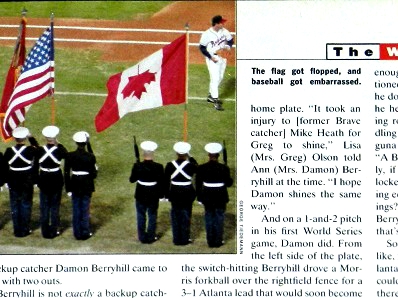
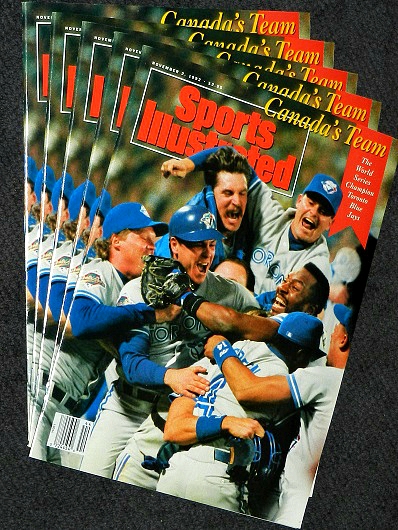
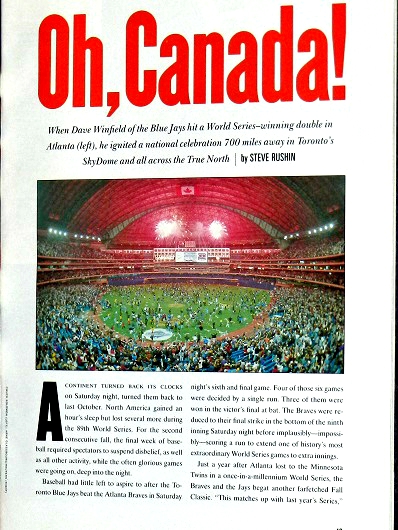
The Blue Jays won the World Series in the wee hours of Oct. 25, 1992 with a 4–3, 11–inning triumph over the Braves in Game 6, before 52,763 at the old cookie–cutter in Atlanta. A two–run double down the left–field line by Dave Winfield off Charlie Leibrandt (b. Oct. 4, 1956) in the top of the 11th broke a 2–2 tie and provided the winning margin. The Nov. 2, 1992 issue of Sports Illustrated (above) showed the triumphant visitors celebrating on the mound after Toronto reliever Mike Timlin (b. Mar. 10, 1966) fielded a bunt by veteran Otis Nixon (b. Jan. 9, 1959) and tossed to Joe Carter (b. Mar. 7, 1960) at first base for the final out.
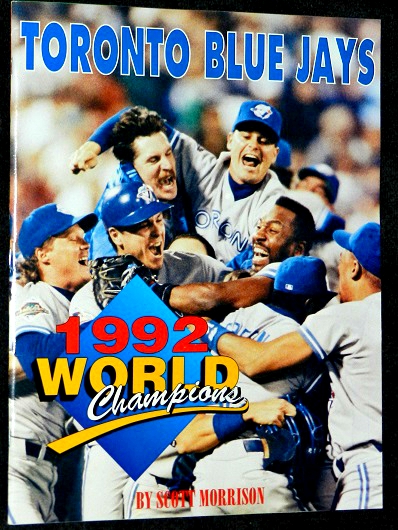
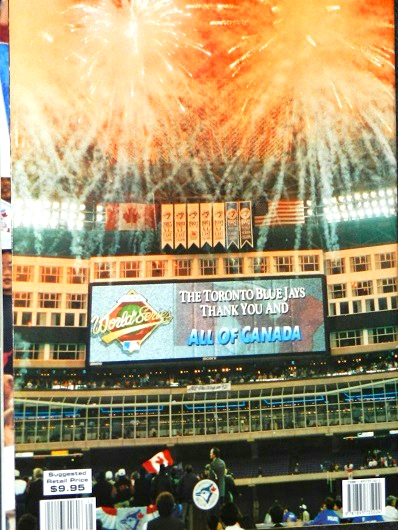
After the Series, the Toronto Sun published this 11×14–inch commemoration; text by Scott Morrison.
EMAIL: HOWARDLBERGER@GMAIL.COM

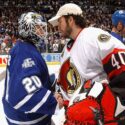






























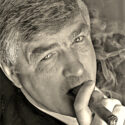
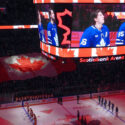


You wonder if the Hall considers the fact that, while Henderson did score those three goals, he wasn’t the best player on Team Canada. Phil Esposito was easily the best player—13 points in the series, 4 of them in game 8 with a goal and two assists in the 3rd period to engineer the Canadian comeback. Not saying Paul shouldn’t be there but he doesn’t get a chance to be hero–and Canada doesn’t win in 1972–without the play of Phil Esposito.
Is there a more “famous” Canadian hockey moment than Henderson’s goal? It IS the Hall of “Fame”, correct? Thus, my argument.